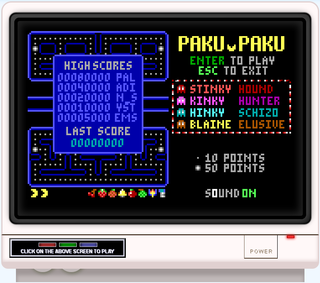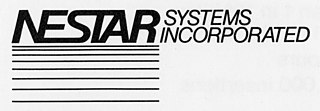
A floppy disk or floppy diskette is a type of disk storage composed of a thin and flexible disk of a magnetic storage medium in a square or nearly square plastic enclosure lined with a fabric that removes dust particles from the spinning disk. The three most popular floppy disks are the 8-inch, 5¼-inch, and 3½-inch floppy disks. Floppy disks store digital data which can be read and written when the disk is inserted into a floppy disk drive (FDD) connected to or inside a computer or other device.

CP/M, originally standing for Control Program/Monitor and later Control Program for Microcomputers, is a mass-market operating system created in 1974 for Intel 8080/85-based microcomputers by Gary Kildall of Digital Research, Inc. CP/M is a disk operating system and its purpose is to organize files on a magnetic storage medium, and to load and run programs stored on a disk. Initially confined to single-tasking on 8-bit processors and no more than 64 kilobytes of memory, later versions of CP/M added multi-user variations and were migrated to 16-bit processors.
In computing, a plug and play (PnP) device or computer bus is one with a specification that facilitates the recognition of a hardware component in a system without the need for physical device configuration or user intervention in resolving resource conflicts. The term "plug and play" has since been expanded to a wide variety of applications to which the same lack of user setup applies.
The computer art scene, or simply artscene, is the community interested and active in the creation of computer-based artwork.
A boot disk is a removable digital data storage medium from which a computer can load and run (boot) an operating system or utility program. The computer must have a built-in program which will load and execute a program from a boot disk meeting certain standards.

The Mindset is an Intel 80186-based MS-DOS personal computer. It was developed by the Mindset Corporation and released in spring 1984. Unlike other IBM PC compatibles of the time, it has custom graphics hardware supporting a 320×200 resolution with 16 simultaneous colors and hardware-accelerated drawing capabilities, including a blitter, allowing it to update the screen 50 times as fast as an IBM standard color graphics adapter. The basic unit was priced at US$1,798. It is conceptually similar to the more successful Amiga released over a year later. Key engineers of both the Amiga and Mindset were ex-Atari, Inc. employees.

Diskworld was a disk magazine for the Apple Macintosh computer system, published by Softdisk beginning in 1988. It was a sister publication of Softdisk for the Apple II, Loadstar for the Commodore 64, and Big Blue Disk for the IBM PC. Diskworld ceased publication in 1998.

A type-in program or type-in listing was computer source code printed in a home computer magazine or book. It was meant to be entered via the keyboard by the reader and then saved to cassette tape or floppy disk. The result was a usable game, utility, or application program.
The Commodore 64 amassed a large software library of nearly 10,000 commercial titles, covering most genres from games to business applications, and many others.

Softdisk was a software and Internet company based in Shreveport, Louisiana. Founded in 1981, its original products were disk magazines. It was affiliated and partly owned by paper magazine Softalk at founding, but survived its demise.

A personal computer game, also known as a computer game or abbreviated PC game, is a video game played on a personal computer (PC).
An online magazine is a magazine published on the Internet, through bulletin board systems and other forms of public computer networks. One of the first magazines to convert from a print magazine format to an online only magazine was the computer magazine Datamation. Some online magazines distributed through the World Wide Web call themselves webzines. An ezine is a more specialized term appropriately used for small magazines and newsletters distributed by any electronic method, for example, by email. Some social groups may use the terms cyberzine and hyperzine when referring to electronically distributed resources. Similarly, some online magazines may refer to themselves as "electronic magazines", "digital magazines", or "e-magazines" to reflect their readership demographics or to capture alternative terms and spellings in online searches.

The PC-9800 series, commonly shortened to PC-98 or 98, is a lineup of Japanese 16-bit and 32-bit personal computers manufactured by NEC from 1982 to 2000. The platform established NEC's dominance in the Japanese personal computer market, and, by 1999, more than 18 million units had been sold. While NEC did not market these specific machines in the West, it sold the NEC APC series, which had similar hardware to early PC-98 models.

Loadstar was a disk magazine for the Commodore 64 computer, published starting in 1984 and ceasing publication in 2007 with its unreleased 250th issue. It derived its name from the command commonly used to execute commercial software from a Commodore 1541 disk: LOAD "*",8,1, with inspiration from the word "lodestar".

Softdisk, originally Softdisk Magazette, was a disk magazine for the Apple II computer line, published from 1981 through 1995. It was the first publication of the company that was also known as Softdisk, which would go on to publish disk magazines for other systems, other software, and later be involved in Internet access, hosting, and development.

Hugi is one of the longest lasting, frequently released demoscene and underground disk magazines (diskmag) for IBM-PC.
A cassette magazine, or tapezine, is a publication contained entirely on computer-readable media, specifically on cassette. Its content consists of some combination of text, graphics, multimedia, and executable programs, and it is normally specific to one particular computer platform or operating system. The successor to the cassette magazine was the disk magazine.

Scene World Magazine is a disk magazine for the Commodore 64 home computer. The magazine has been released regularly since February 2001.

Nestar Systems, Inc., was an early independent manufacturer of pre-internet local area networks for personal computers from 1978 to 1986 and was considered "a pioneer in the industry". It produced three major generations of products:












